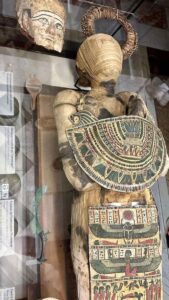Introduction to Ancient Egyptian Funerary Art
The ancient Egyptians are renowned for their complex and refined funerary rituals, which aimed to prepare the deceased for their journey to the afterlife. For this civilization, commemorating and honoring the souls of the departed was not only a cultural practice but also a profound belief in life after death. Artifacts such as intricately adorned mummies, masks, and unique funerary items vividly reflect the Egyptians’ faith, artistry, and respect for those who had passed.
Mummy Statues – Symbols of Faith and Protection for the Soul
The mummy statues are crafted with meticulous care, adorned with elaborate decorations that reflect Egyptian religion, art, and tradition. At the statue’s center is an intricate chest piece (often referred to as pectorals) with vibrant patterns depicting sacred imagery and protective symbols. These decorative details, including winged deities, sacred animals, and geometric patterns, carry aesthetic value while also symbolizing protection for the soul, safeguarding it from dangers as it journeys into the afterlife.
Analysis of Winged Figures and Geometric Patterns
The winged figures, which often appear in funerary artifacts, represent divine protection from the gods. The intricate geometric designs are not only decorative but also embody cosmic harmony and the belief in an orderly universe. For the ancient Egyptians, every image held significance, reflecting the bond between humans and the divine.

The Revered Mask – Preserving the Deceased’s Identity
A central component of Egyptian funerary rituals was the mask placed near or directly on the mummy. This mask served not only as protection but also as a way to preserve the identity of the deceased in the spiritual realm. The bold colors and carefully painted facial features create a sacred image, embodying the belief that the individual’s likeness would help them maintain their identity and continue to exist in the afterlife.
Analyzing Decorative Details and Symbolism of the Mask
Masks were typically made from gold or wood, adorned with symbolic designs and colors associated with divinity. The choice of colors also held deep religious meaning: blue and gold often symbolized eternity and rebirth, embodied by deities like Horus or Osiris. This emphasizes that, in ancient Egyptian culture, death was not an end but a transition.

Funerary Artifacts – Expressions of Reverence
Beyond statues and masks, the Egyptians prepared various funerary items, including statues of deities, jewelry, and other objects placed around the mummy. These items served as offerings meant to help the deceased adapt and receive the gods’ assistance in the afterlife.
Spiritual Significance of Funerary Artifacts
Each funerary item held spiritual meaning, symbolizing respect for the deceased and divine protection. They were crafted with exquisite skill, reflecting the advanced technical and artistic capabilities of the ancient Egyptians. Small statues, deity figurines, and jewelry served as symbols of protection and support for the soul’s journey, highlighting a strong belief in the protective and guiding powers of the gods.

Conclusion – The Enduring Value of Egyptian Funerary Art
Ancient Egyptian funerary artifacts vividly demonstrate the art, religion, and belief in the afterlife. From the intricate patterns on mummy statues and the detailed features on masks to the funerary items placed around them, all of these elements reflect a rich culture and unshakeable faith in life beyond death. This funerary art not only honors the deceased but also serves as a reminder of the endurance of culture and human faith.
Over thousands of years, these artifacts have retained their value, shedding light on the deep beliefs of the ancient Egyptians and their dedication to remembering the dead. Mummy statues, masks, and funerary items stand as symbols of a brilliant civilization, eternally preparing for life everlasting.
